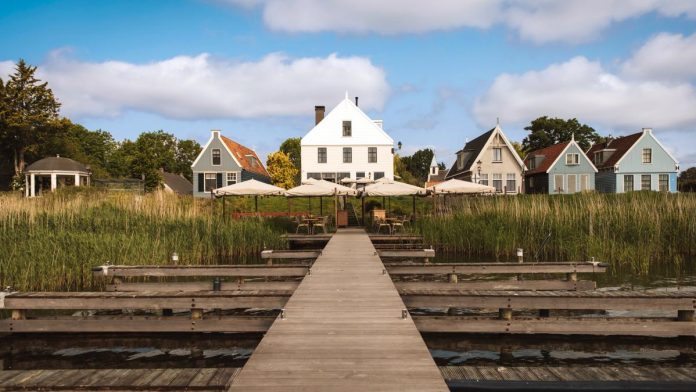The Hotel De Durgerdam is very close to Amsterdam and yet in another world. It is also a showcase for sustainable, artistically sophisticated design. The atmosphere of the rooms is reminiscent of the pictures of the old masters. A visit.
When traffic is moving, it's really only a ten-minute drive from Amsterdam Centraal to Durgerdam: through the Zeeburgertunnel, then a little to the right – and you're in the village. Not in a rural suburb, but a village in the sense of a picture book. 500 people live in Durgerdam in a few dozen brick and wooden houses. They were built in simplicity, and until a few decades ago no one really wanted to know anything about them. Today they are one of the best locations in Amsterdam, even if it is technically no longer Amsterdam. Durgerdam is a port settlement that was built in the 15th century. At that time it was still on a bay. In 1932, a dam was built at the entrance to the bay, so that the “IJmeer”, which spills over the dike here, is now a freshwater lake. This hasn't changed the maritime charm: sea grass grows on the shore, water birds nest, clotheslines are stretched over the dike, sailing boats bob on the waves and larger ships pass in the distance. On the other side, within sight, lies modern Amsterdam with tall residential and commercial buildings like an unlikely AI backdrop. Being on this side of reality feels like a surprising gift.
There has been exactly one guesthouse with an attached restaurant in Durgerdam since the 17th century. This spring, De Durgerdam, as the hotel and restaurant are now called, opened under new ownership, Dutch real estate developers Aedes, following a major remodel under the creative direction of Amsterdam design studio Buro Belén. Its founders Brecht Duijf and Lenneke Langenhuijsen met at the design academy in Eindhoven. They are considered materials researchers and are known for objects and furniture that make textiles and textures appear surprising. Aedes – courageously – commissioned them as designers for the demanding Durgerdam project. It was the first major project for the two women and it certainly won't be their last. What they have designed together with the far-sighted real estate developer is not only exceptionally appealing, but could even serve as a blueprint for how the renovation of historic houses can be handled sensitively and sustainably elsewhere. Not because the style of the house could be adopted anywhere else in the world, but the approach certainly is.
“De Durgerdam” only has 14 rooms, spread over an annex and the historic main building. There is a gable suite under the roof that takes the hotel's atmosphere to the extreme in the truest sense of the word: the large bed with crisp white bed linen nestles into a niche on three sides. On the bed lies a velvet blanket that shimmers with a golden-greenish tint depending on the light, as if thrown down by chance. The contrast between the materials, taut and flowing, matt and shiny, solid and soft, is framed by the warm wood tone of the walls. You feel like you can feel the vibrations of the colors – as if you were entering the still life of an Old Master. The light that falls into the room from outside constantly changes the nuances. At the narrow window with the natural white linen curtains there is a small wooden desk with gracefully turned legs and a corresponding chair. On the table a golden brass lamp and a pair of binoculars. This gives you a view of the blue-gray lake and the restless sky. Up here you feel protected and ready to admire any weather.
The interplay between the inside and outside, emphasized by flowing transitions in color, was a design concern of Duijf and Langenhuijsen. Working out the effect of colors and materials is also her specialty. Above all this is the contemporary integration of the region's historical heritage. To realize the project, the designers worked with the “Zuiderzeemuseum”, an open-air museum that provides information about life and the historical combination of architecture, craftsmanship and nature or the sea: “It is strongly connected to each other,” says Brecht Duijf. “Fishing influenced the architecture in every respect and every village had its own color.” As in a research project, they explored the possibilities: old tiles and bricks were – if possible – preserved and replaced with new, but traditionally made pieces by the “Royal Tichelaar Makkum” added. The furniture was either designed and specially made by the designers, or it is antique pieces and flea market finds. Nothing is unintentional: you can look into every cupboard and on every wall and even ponder the nature of the cushions and discover yet another meaningful detail. But you don't have to do any of that, because the feeling of harmony that greets guests here is self-explanatory: “We have gone very far, with a lot of commitment and enthusiasm,” says Lenneke Langenhuijsen.
The same could be said about the work of Aedes: The developer, who is known for large-scale projects such as the Soho House in Amsterdam, has set a sustainable example with “De Durgerdam”: a heat pump is installed behind the house and the useful water is recycled , just like some building materials. Aedes owner Paul Geertman also made part of his private art collection available, including works by 100 regional artists. The restaurant is also frequented by the neighborhood, and for those who don't want to go to Amsterdam, bike tours are offered. You walk across fields, through old villages and along the coast. What catches the eye is that dikes are being raised everywhere. Bulwarks against the consequences of climate change. “De Durgerdam” appears there – in its context also as a clever commentary on it.


